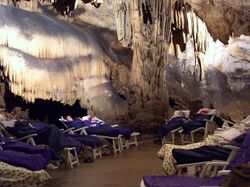Unsolved:Halotherapy
| This article is part of a series on |
| Alternative and pseudo‑medicine |
|---|
 |
Halotherapy (also known as speleotherapy when practiced inside caves) is a form of alternative medicine which makes use of salt. Halotherapy is an unproven treatment that lacks scientific credibility.[1] Spa owners attribute a wide range of health benefits to halotherapy.[2]
Norman Edelman of the American Lung Association suggests that, for people with obstructive lung diseases, halotherapy might be more than placebo effect.[3] He speculates that inhaled salt particles might thin out mucus aiding patients in expelling sputum. However, a recent review of the research supporting halotherapy determined that, out of 151 studies conducted on this topic, only 1 was a well-designed randomized control trial that met their inclusion criteria for a meta-analysis.[4]
History
Many forms of halotherapy have been used for millennia.[citation needed] The earliest known mention of spa resorts date back to 12th-century Poland, in which people were urged to bathe in mineral waters.[5] Modern history of halotherapy dates back to 1843, when a Poland physician named Feliks Boczkowski promoted the idea of salt treatment after noticing that workers at salt mines, unlike other miners, did not have respiratory or lung problems.[6] In those regions where there are natural karst caves as well as numerous salt tunnels and salt mines, therapeutic centers for asthma sufferers have been established since the 1950s, notably in Slovakia,[7] Romania, as well as Ukraine, in addition to Poland.[8]
Forms
There are several forms of halotherapy:[5]
- Saline solution inhalations
- Dry salt aerosol inhalations
- Irrigation and lavage
- Saline and brine baths
- Taking the waters (crenotherapy)
See also
- Balneotherapy, the medical use of bathing
- Speleotherapy
- Thalassotherapy, the medical use of seawater
References
- ↑ Shah, R.; Greenberger, P. (2012). "Unproved and controversial methods and theories in allergy-immunology". Allergy and Asthma Proceedings 33 (Supplement 1): 100–102. doi:10.2500/aap.2012.33.3562. PMID 22794702.
- ↑ Novella, Steven (June 13, 2018). "Halotherapy – The Latest Spa Pseudoscience". https://sciencebasedmedicine.org/halotherapy-the-latest-spa-pseudoscience/.
- ↑ "Promising or Placebo? Halo Salt Therapy: Resurgence of a Salt Cave Spa Treatment". June 9, 2016. http://www.lung.org/about-us/blog/2016/06/promising-placebo-salt-halotherapy.html.
- ↑ Rashleigh, Rachel; Smith, Sheree (February 21, 2014). "A review of halotherapy for chronic obstructive pulmonary disease". International Journal of Chronic Obstructive Pulmonary Disease 9: 239–46. doi:10.2147/COPD.S57511. PMID 24591823.
- ↑ 5.0 5.1 Kamińska, Katarzyna (2014). Halotherapy. Sulejówek: Salsano Haloterapia Polska. p. Transl. Caryl Swift. ISBN 978-83-937819-1-1.
- ↑ Shah, Allie (18 November 2013). "Salt therapy is finding new fans, but doctors remain skeptical". Milwaukee Journal Sentinel. http://archive.jsonline.com/news/health/salt-therapy-is-finding-new-fans-but-doctors-remain-skeptical-b99139609z1-232274891.html/.
- ↑ a.s, Petit Press (2007-04-30). "Caves offer asthma relief for tourists" (in en). https://spectator.sme.sk/c/20005013/caves-offer-asthma-relief-for-tourists.html.
- ↑ "Ukrainian mine helps asthmatics" (in en-GB). 2006-01-03. http://news.bbc.co.uk/2/hi/europe/4575388.stm.
External links
- Dunning, Brian (2013-08-13). "Skeptoid #376: Salt Therapies". https://skeptoid.com/episodes/4376.
 |



